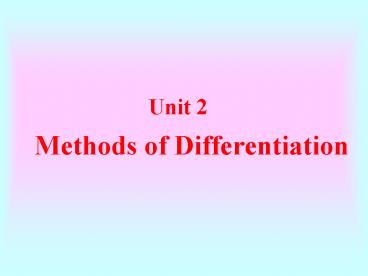Methods of Differentiation - PowerPoint PPT Presentation
1 / 49
Title:
Methods of Differentiation
Description:
2.2 Rules for Differentiation of Composite Functions and Inverse Functions ... The natural logarithm of x is denoted by ln x or loge x or log x. ... – PowerPoint PPT presentation
Number of Views:249
Avg rating:3.0/5.0
Title: Methods of Differentiation
1
Unit 2
- Methods of Differentiation
2
2.1 Fundamental Formulas for Differentiation
3
2.1 Fundamental Formulas for Differentiation
4
2.2 Rules for Differentiation of Composite
Functions and Inverse Functions
The chain rule
5
2.2 Rules for Differentiation of Composite
Functions and Inverse Functions
6
2.2 Rules for Differentiation of Composite
Functions and Inverse Functions
7
2.2 Rules for Differentiation of Composite
Functions and Inverse Functions
8
2.2 Rules for Differentiation of Composite
Functions and Inverse Functions
9
2.3 The Number e
10
2.4 Differentiation of Logarithmic and
Exponential Functions
The symbol logax denotes the logarithm of the
number x to the base a.
Properties of logarithm
- loga1 0 and logaa 1
- loga(xy) logax logay
11
2.4 Differentiation of Logarithmic and
Exponential Functions
Properties of logarithm
(4) logaxn nlogax, for any real number n.
12
2.4 Differentiation of Logarithmic and
Exponential Functions
Logarithm to the base e is called natural
logarithm or Napierian logarithm. The natural
logarithm of x is denoted by ln x or loge x or
log x.
13
2.4 Differentiation of Logarithmic and
Exponential Functions
14
2.4 Differentiation of Logarithmic and
Exponential Functions
15
2.4 Differentiation of Logarithmic and
Exponential Functions
Readers should not make the following mistakes
16
2.4 Differentiation of Logarithmic and
Exponential Functions
17
2.4 Differentiation of Logarithmic and
Exponential Functions
18
2.4 Differentiation of Logarithmic and
Exponential Functions
Graphs of Logarithmic Functions
19
2.4 Differentiation of Logarithmic and
Exponential Functions
Graphs of Exponential Functions
20
P.46 Ex.2A
21
2.5 Differentiation of Trigonometric Functions
22
2.5 Differentiation of Trigonometric Functions
23
2.5 Differentiation of Trigonometric Functions
Differentiation of trigonometric functions
24
2.5 Differentiation of Trigonometric Functions
If u is a differentiable function of x,
25
2.6 The Inverse Trigonometric Functions
The function y sin-1x is equivalent to x siny.
The other five functions y cos-1x, y tan-1x,
y cot-1x, y sec-1x and y csc-1x are defined
similarly. These six functions are called inverse
trigonometric functions or inverse circular
functions.
26
2.6 The Inverse Trigonometric Functions
27
2.6 The Inverse Trigonometric Functions
Graphs of six inverse trigonometric functions
28
2.6 The Inverse Trigonometric Functions
Graphs of six inverse trigonometric functions
29
2.6 The Inverse Trigonometric Functions
Relationship between inverse function of sine and
cosine
30
2.6 The Inverse Trigonometric Functions
31
P.51 Ex.2B
32
2.7 Differentiation of Inverse Trigonometric
Functions
33
2.7 Differentiation of Inverse Trigonometric
Functions
If u is a differentiable function of x,
34
P.54 Ex.2C
35
2.8 Equations of Tangents and Normals to a Curve
Let P and Q be two points on a curve and suppose
a straight line is drawn through them, then the
limiting position PT of this straight line as Q
moves along the curve and approaches P as a
limit, is called a tangent to the curve at the
point P.
36
2.8 Equations of Tangents and Normals to a Curve
The straight line line perpendicular to the
tangent at the point of contact is called the
normal to the curve at that point.
37
2.8 Equations of Tangents and Normals to a Curve
The angles between two curves at that point of
intersection are the angles between the two
tangents to these curves at that point.
38
2.8 Equations of Tangents and Normals to a Curve
39
P.56 Ex.2D
40
2.9 Second Derivatives
41
P.58 Ex.2E
42
2.10 Indeterminate Forms and LHospitalsRule
The limit of a non-constant function f(x) as x
tends to x0 is said to be an indeterminate of the
form.
43
2.10 Indeterminate Forms and LHospitalsRule
44
2.10 Indeterminate Forms and LHospitalsRule
45
2.10 Indeterminate Forms and LHospitalsRule
LHospitals rule
46
P.63 Ex. 2F
47
2.11 Differential and Small Increment
Let y f(x). The increment ?x of the independent
variable x is called the differential of x,
denoted by dx. The differential of y or the
differential of f(x), denoted by dy or df(x)
respectively, is defined by dy df(x) f (x)?x
f (x)dx, where f (x) is the derivative of
f(x).
48
P.68 Ex. 2G
49
P.68 Ex. 2H































